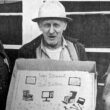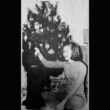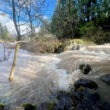Sean C. Morgan
The Sweet Home Planning Commission Monday evening unanimously approved conditional use permits that will allow the construction of two communications poles, one by Verizon Wireless to improve its service in town and one to communicate with the Falls Creek Hydroelectric Project about 25 miles east of Sweet Home.
Conditional uses are uses allowed in different zones that may require special conditions before being permitted. They require a public hearing at the Planning Commission.
Verizon Wireless
The Planning Commission approved a 100-foot monopole and associated equipment on a 50-foot by 50-foot section at 1602 18th Ave., industrial property owned by Lester Sales. According to the applicant, the facility is intended to fill a significant gap in Verizon’s 4G coverage and expand capacity for Sweet Home customers.
According to Verizon’s application, Verizon has one wireless site serving the Sweet Home area and it has limited capacity.
To remedy the reduced capacity, the 18th Avenue site is proposed so that calls at surrounding sites can be “offloaded,” creating more wireless capacity for the vicinity, the application said.
“For this capacity off-loading to be successful, precise placement of the new antennas is necessary.”
Sweet Home code requires telecommunications companies to use existing towers, if possible, before building a new one. Verizon considered two sites outside of its “search ring,” the area where the new facility must be located to provide effective service, according to the company’s application. It also looked at a 50-foot power pole off 18th Avenue, but none of the alternatives would provide the required coverage or capacity.
Tamarack Street resident Tim Breedan opposed the application because it is within 60 feet of the main electrical transmission lines that “power our entire city.”
“In the case of the expected Cascadia (Subduction Zone) earthquake event, this 100-foot tower would be accelerated to the east by a westbound tremor,” Breeden said. “This would land it right on the power lines that feed the entire city. With just a little common sense planning, this could be avoided. The Planning Commission must intervene to stop this disastrous plan from being implemented.”
The applicant will construct the facility based on building and structural codes, said Michael Birndorf, site acquisition specialist for Velocitel, which represented Verizon. When Verizon submits its building permit application, it also will submit an engineering report that addresses wind and earthquakes.
“It will not be an issue with the power lines,” he said. “There’s no set requirement to be set back a certain distance from power lines.”
The tower will be designed to meet safety standards, just like a building, Birndorf said.
“It’s going to be over-engineered to begin with. Typically, they overbuild these things.”
“The seismic standards do not guarantee the tower will not fail,” Breeden said, and moving it is a much better approach.
He also criticized the “propagation maps” included with the application, noting that they contradict each other and Verizon’s website, which shows Sweet Home has full coverage.
“Obviously, Verizon is working to make a significant investment,” Birndorf said. “They wouldn’t do it unless they felt it was needed.”
He added that it isn’t just about providing coverage, it’s also about expanding capacity, allowing more customers to use the towers and to bring the latest technological upgrades to Sweet Home.
Commissioner Jeff Parker said it would set some minds at ease if Verizon could move the pole to another location on the property.
Commissioner Eva Jurney asked if it were feasible to move it.
Birndorf said it might be, but he would need to get the property owner’s approval.
“I have to believe that the building codes take into consideration how close it it is to the power lines,” said Commissioner Greg Stephens. “They wouldn’t do it there unless they can do it safely.”
“Aesthetically, it’s probably a good choice,” said Commissioner Henry Wolthuis, noting that it’s on industrial property.
Commissioner Herb Thomas, Stephens and Wolthuis all said an earthquake would cause more, bigger problems than the loss of power lines at that location.
The commission approved the conditional use permit 5-0. Present were Parker, Herb, Wolthuis, Stephens and Jurney. Greg Korn and Chairman Lance Gatchell were absent.
Falls Creek Hydroelectric Project
The Falls Creek Hydroelectric Project proposed building a 40-foot monopole at the south wall of the Sweet Home Elks Lodge, 440 Osage St., which is located in a low-density residential zone.
At the top of the pole, 13 feet above the roof of the Elks Lodge, a transmitter will send a uni-directional signal east to Huss Ridge, east of the Upper Soda area in the Sweet Home Ranger District. The Huss Ridge site will send the signal west to the Falls Creek Project, said owner Gary Marcus of Eugene.
He developed the project, located across the South Santiam River from Trout Creek Campground, in 1984. Marcus said it generates 15.5 megawatts of power, and it is one of the first low-impact projects in the world.
The project requires direct line of sight for communication, Marcus said, and Riggs Hill blocked an alternative on Marks Ridge.
Marcus said the Falls Creek antenna would be the only communications equipment on the pole.
Marcus addressed three concerns about the project.
He told the commission that the radiation emissions from the tower were 35,000 times lower than the Federal Communications Commission’s regulation and vastly lower than that of cell phones, microwaves and household routers.
It also will not interfere with other radio equipment in the area, Marcus said, because the signal is uni-directional.
Five neighbors primarily objected to or were concerned about the appearance of the pole and the noise a backup generator would produce.
Noting that the Elks Lodge had a 56-foot communications pole attached to the building from 1997 to 2016, Marcus told the commission that the property is surrounded by much taller trees. From the ground at the location of the pole, two houses are partially visible through the trees.
He tied brightly colored balloons at the height of the tower, he said, and traveled around the area. From the front of the Elks Lodge, they were barely visible, and they were slightly visible from one location on Strawberry Loop.
One resident noted that many of the homes there have two stories, and on the second floor, the antenna will still be visible.
Marcus said the propane generator will only turn on during a long power outage after the 48-hour batteries run out of power.
The unit must be tested monthly, he said, but that will be done during the day.
Speaking on behalf of the Sweet Home Fire and Ambulance District in support of the application, Lt. Zach Lincoln told the Planning Commission that the district plans to add repeater equipment to the Falls Creek Huss Ridge site to provide radio coverage east of Tombstone Pass.
The district has been responding to Tamolitch Falls and Blue Pool more frequently in recent years, and it takes medics away from the district for up to seven hours, Lincoln said. During that time, they cannot receive any communication.
With the approval, the district could put the repeater gear up before the snow covers Huss Ridge and have it ready to go by next summer, Lincoln said. The district could not afford to build its own tower there.
“This Elks Lodge has done so much in the community over the years,” said Randy Claasen, past exalted ruler and leading knight, in support of the conditional use permit. The lodge has put in $200,000 worth of improvements and is now giving the exterior of the building some attention. “We are taking care of our building.”
Among opponents, neighbor Ken Collins said he prefers an alternative site on Marks Ridge, which could also help the local ham radio group.
Neighbor Kathi Collins said it sets a bad precedent, allowing a communications tower in a low-density residential zone.
Neighbor Tom Albert wanted to ensure that the vegetation, the trees surrounding the property, will remain in place. Removal of the trees would impact the neighborhood.
“I care about the neighbors,” Marcus said. “Because I care, I’ve done everything I can to make this invisible.”
The equipment will be painted to help camouflage it, he said. He will continue to talk with neighbors.
Breeden contended that the tower is not structurally tied to the Elks Lodge and is in fact a free-standing ground-based pole and not allowed in the residential zone.
The “ice bridge,” which isn’t necessary in Sweet Home’s climate and is described as an attachment point, is nothing more than a shield to protect the wires, Breeden said. It is not a structural component.
During discussion about the proposal, Parker said the antenna is just 13 feet taller than the Elks Lodge itself, and because the antenna points to the east above Osage Street, there will be no loss of vegetation around the property.
It will have no lights, and the generator will only run when power is out, the pole will be much less intrusive on the neighborhood, he said.
Herb has lived within 50 feet of a propane generator, which are quieter than gas generators, he said. “You don’t hear it. It’s literally a whisper.”
Moving it closer to the building makes it much less intrusive, Stephens said. “I’m fine with it.”
Initially, the pole was proposed to be 12 feet from the building.
“I think this is as ideal as it can be made with the job to be done,” Wolthuis said.
The Planning Commission voted 5-0 to approve the conditional use permit.




